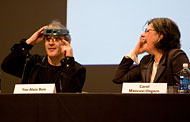The Object in Transition

|
|
Since the middle of the twentieth century, artists have increasingly turned to a variety of new materials and techniques for art making. Many of these materials and techniques have produced objects that alter rapidly in appearance and require some level of intervention to enable their continued display. These works pose strong challenges to the fields of conservation and art history. There is often no codified method for conserving such works; further, the insistent but uneven rate of deterioration present in many objects has left us with countless works of art that now diverge starkly from their original form. The practical and interpretative problems that arise in relation to durability and ephemerality in modern and contemporary art are exacerbated by an art-historical methodology that tends to privilege theoretical interpretation over concrete object study. The descriptive knowledge that originates in object- and technique-based study has increasingly left the field of art history, falling instead within the domain of art conservation. Curators and historians of contemporary art have in recent years shown renewed interest in object-based study, but the requisite training is no longer part of advanced art-historical study. Conversely, conservators by necessity study art through the empirical and scientific analysis of objects. However, the challenges posed by modern materials often lead to decisions about an object's preservation and acceptable aging that are based on more subjective inferences about the artist's original intent—an interpretive concept that many art historians view with some skepticism.
A primarily object-based study of art offers both enormous possibilities and specific limitations, and increased dialogue between the fields of art history and conservation can only prove beneficial in better defining these parameters. This two-day conference aims to foster such communication by presenting joint research from art historians and conservators on specific case studies—in many instances with the objects in question available for viewing—and by spurring intensive dialogues among professionals from both fields regarding some of the pressing and difficult issues manifested by objects made from modern materials.
Artists Rachel Harrison, Paul McCarthy, and Doris Salcedo join curator Elisabeth Sussman and conservator Christian Scheidemann in discussing the often complex production process of their art works, the ephemeral nature of some of the modern materials from which they are created, and the implications this may have for the long-term survival of their art.